
Vigo Street (originally Vigo Lane) [1] is a short street in central London that is named after the Anglo-Dutch naval victory over the French and Spanish in the 1702 Battle of Vigo Bay. [2] [3] It has important literary connections.

Vigo Street (originally Vigo Lane) [1] is a short street in central London that is named after the Anglo-Dutch naval victory over the French and Spanish in the 1702 Battle of Vigo Bay. [2] [3] It has important literary connections.

The street runs between Regent Street and the junction of Burlington Gardens and Savile Row. Sackville Street leads south, half way along Vigo Street. The rear entrance to Albany is wedged between the end of Vigo Street and the start of Burlington Gardens at 10 and 12 Burlington Gardens.
Originally, the whole roadway from what is now Bond Street to the current Glasshouse Street, including the current Vigo Street, was called Glasshouse Street. [4]
Following the Anglo-Dutch naval victory over the French and Spanish in the 1702 Battle of Vigo Bay, part of Glasshouse Street was renamed Vigo Lane. [2] Later it became Vigo Street, but the name "Vigo Lane" was still used in Elmes's London Streets as late as 1831. [1]
Finally, the part of Vigo Street behind Burlington House was renamed Burlington Gardens by 1831. [1] [4]
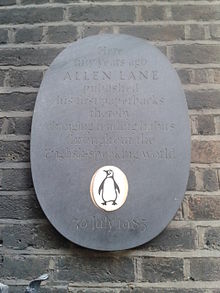
Publishers John Lane and Elkin Mathews were in partnership in Vigo Street. Together they published the infamous literary journal The Yellow Book volumes one and two in 1894. Later they founded The Bodley Head and continued to publish the work until it ceased in 1897.
When the partnership between Lane and Mathews ended, both continued to have premises in Vigo Street and Mathews published the first editions of a number of important literary works, including The Wind Among the Reeds by W. B. Yeats in 1899 Chamber Music by James Joyce in 1907. He also published Lionel Johnson, John Masefield, J.M. Synge and Ezra Pound. [5]
It was from 8 Vigo Street that Allen Lane founded Penguin Books as part of Bodley Head in 1935. In 1985, Penguin erected a plaque on number 8 to mark the fiftieth anniversary of the Penguin paperback. [6]
In Conan Doyle's The Lost World, 1912, a South American adventure, Lord John Roxton, turns down Vigo street and 'through the dingy portals of the famous aristocratic rookery' to his Albany chambers. Doyle describes his rooms, art and gun collection, in great detail.
In Graham Greene's The End of the Affair, 1951, the private detective agency Bendrix approaches is located at 159 Vigo Street.

Charing Cross Road is a street in central London running immediately north of St Martin-in-the-Fields to St Giles Circus, which then merges into Tottenham Court Road. It leads from the north in the direction of Charing Cross at the south side of Trafalgar Square. It connects via St Martin's Place and the motorised east side of the square.

The Mysterious Affair at Styles is the first detective novel by British writer Agatha Christie, introducing her fictional detective Hercule Poirot. It was written in the middle of the First World War, in 1916, and first published by John Lane in the United States in October 1920 and in the United Kingdom by The Bodley Head on 21 January 1921.
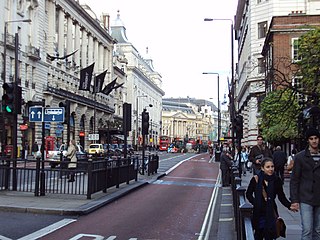
Piccadilly is a road in the City of Westminster, London, England, to the south of Mayfair, between Hyde Park Corner in the west and Piccadilly Circus in the east. It is part of the A4 road that connects central London to Hammersmith, Earl's Court, Heathrow Airport and the M4 motorway westward. St James's is to the south of the eastern section, while the western section is built up only on the northern side. Piccadilly is just under 1 mile (1.6 km) in length, and it is one of the widest and straightest streets in central London.
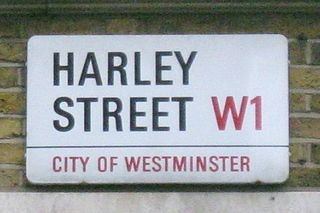
Harley Street is a street in Marylebone, Central London, named after Edward Harley, 2nd Earl of Oxford and Earl Mortimer. Since the 19th century it has housed a large number of private specialists in medicine and surgery.

Penguin Books Limited is a British publishing house. It was co-founded in 1935 by Allen Lane with his brothers Richard and John, as a line of the publishers The Bodley Head, only becoming a separate company the following year. Penguin revolutionised publishing in the 1930s through its inexpensive paperbacks, sold through Woolworths and other stores for sixpence, bringing high-quality fiction and non-fiction to the mass market. Its success showed that large audiences existed for several books. It also affected modern British popular culture significantly through its books concerning politics, the arts, and science.
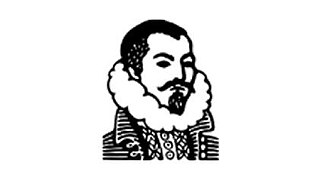
The Bodley Head is an English book publishing imprint of Penguin Random House. Founded in 1887 by John Lane and Elkin Mathews, The Bodley Head existed as an independent entity or as part of multiple consortiums until it was acquired by Random House in 1987 alongside sister companies Jonathan Cape and Chatto & Windus. Random House used The Bodley Head as a children's book imprint until April 2008, when it was repositioned as an adult non-fiction imprint within the Vintage Books division.

John Lane was a British publisher who co-founded The Bodley Head with Charles Elkin Mathews.
Charles Elkin Mathews was a British publisher and bookseller who played an important role in the literary life of London in the late 19th and early 20th centuries.
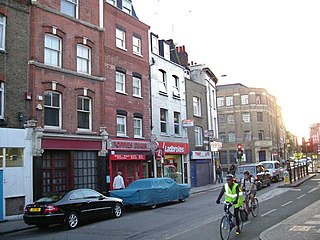
Cable Street is a road in the East End of London, England, with several historic landmarks nearby. It was made famous by the Battle of Cable Street in 1936.

The Highway, part of which was formerly known as the Ratcliffe Highway, is a road in the London Borough of Tower Hamlets, in the East End of London. The route dates back to Roman times. In the 19th century it had a reputation for vice and crime and was the location of the Ratcliff Highway murders. Prior to a renaming programme of 1937, different parts of the route had different names depending on what district they were in.
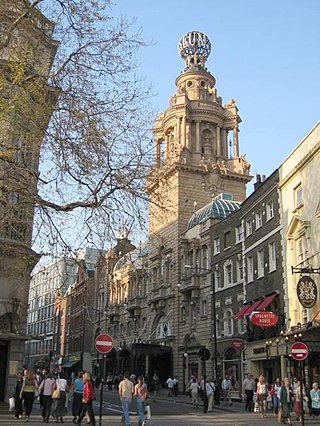
St Martin's Lane is a street in the City of Westminster, which runs from the church of St Martin-in-the-Fields, after which it is named, near Trafalgar Square northwards to Long Acre. At its northern end, it becomes Monmouth Street. St Martin's Lane and Monmouth Street together form the B404.

Sir Allen Lane was a British publisher who together with his brothers Richard and John Lane founded Penguin Books in 1935, bringing high-quality paperback fiction and non-fiction to the mass market.

St John Zachary was a church, first mentioned in official records in 1181, within the City of London, England, on the north side of Gresham Street, Aldersgate. Its vicar from 25 May 1424 to an unknown date was William Byngham, the founder of England's first teacher training college. It was destroyed in the Great Fire of London in 1666 and not rebuilt, with its parish being united with that of St Anne and St Agnes by Act of Parliament in 1670 –an arrangement that lasted until the 20th century. Its site is now a garden, first made by the fire watchers in 1941. Partial records survive at IGI.
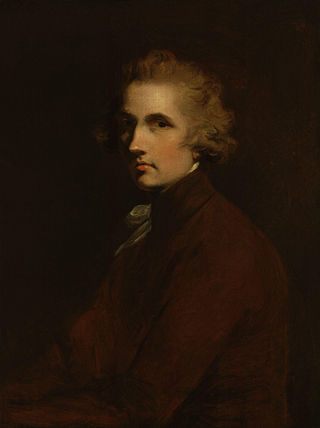
Daniel Gardner was a British painter, best known for his work as a portraitist. He established a fashionable studio in Bond Street in London, specializing in small scale portraits in pastel, crayons or gouache, often borrowing Reynolds' poses.
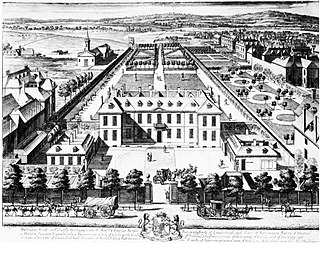
Burlington Gardens is a street in central London, on land that was once part of the Burlington Estate.
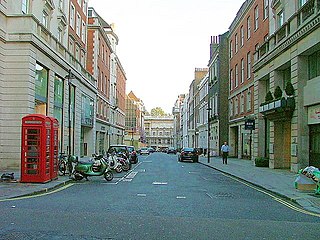
Sackville Street is a street in central London which today is mainly composed of offices and the rears of retail premises, but once was the home to several important medical figures.
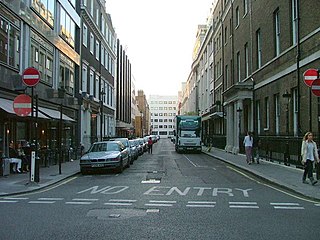
Old Burlington Street is a street in central London that is on land that was once part of the Burlington Estate.

Fore Street is a street in the City of London, England, near the Barbican Centre. It runs from Wood Street to Fore Street Avenue and is joined by Moor Lane on its north side. The street was extensively damaged by Nazi bombing during World War II and, following later development, nothing now remains of its original buildings other than St Giles-without-Cripplegate, which is a short distance away from the modern street.

Maiden Lane is a street in Covent Garden, London, that runs from Bedford Street in the west to Southampton Street in the east. The painter J. M. W. Turner was born on this street in 1775.
This is a list of the etymology of street names in the London district of Mayfair, in the City of Westminster. It utilises the generally accepted boundaries of Mayfair viz. Marble Arch/Cumberland Gate and Oxford Street to the north, Regent Street to the east, Piccadilly to the south and Park Lane to the west.